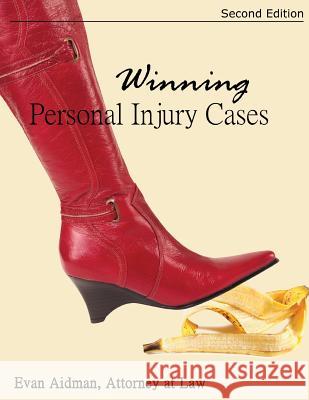Winning Personal Injury Cases: A Personal Injury Lawyer's Guide to Compensation in Personal Injury Litigation » książka
Winning Personal Injury Cases: A Personal Injury Lawyer's Guide to Compensation in Personal Injury Litigation
ISBN-13: 9781514188101 / Angielski / Miękka / 2015 / 446 str.
Winning Personal Injury Cases: A Personal Injury Lawyer's Guide to Compensation in Personal Injury Litigation
ISBN-13: 9781514188101 / Angielski / Miękka / 2015 / 446 str.
(netto: 74,83 VAT: 5%)
Najniższa cena z 30 dni: 78,57
ok. 16-18 dni roboczych
Bez gwarancji dostawy przed świętami
Darmowa dostawa!
Everyone has an opinion about personal injury litigation. Many people feel that the right to sue for injuries should be severely limited in hopes that insurance costs will decrease. Others fear that legislation enacted to restrict the right to sue will make big business, the insurance industry, and medical practitioners less accountable to the public. They also fear the loss of financial compensation for injuries caused by a negligent or careless act. In this book, I examine every aspect of personal injury litigation, from attracting new clients to jury trials, and beyond. The personal injury laws vary from state to state and between state and federal court. Since 1983, I have been a trial lawyer in Pennsylvania and New Jersey. Much of the information presented involves those experiences. The law in your state may be different. Nevertheless, there is much uniformity throughout the states. The information in this book can be used by personal injury litigants and their counsel in any state. You may have to refer to local sources for the law or practice that applies to your situation. The law is dynamic and ever-changing. It is flexible enough to accommodate a changing world. When the first automobile accident lawsuit was filed, the judge was not deterred by the fact that there were no automobile laws for guidance. The judge simply looked to the legal logic of horse-and-buggy cases. Similarly, when new technologies cause injuries in the future, the law will evolve to accommodate this. The federal and state legislatures constantly pass new laws. The courts rule every day on disputes that require interpretation of new laws and old. When a court decides a dispute, the court's ruling becomes precedent for the future. In other words, the interpretations that the judges dispense become the laws by which future litigants can be guided. This concept is known by the Latin term stare decisis. Sample Forms and Worksheets A book like this one cannot possibly include every procedural requirement of every jurisdiction in our country. The sample forms provided are general in nature, but are designed to give you a good idea of the types of forms that are used in most locations. Your state, county, and/or judge will have rules and forms that are not included in this book. Check with the court clerk and/or court website for your case to review any local rules and forms that apply. Often, such forms require the same information as the forms in this book, and are merely laid out differently or use slightly different language. You must follow the court's rules and use its forms. When those forms conflict with mine, use theirs.
Zawartość książki może nie spełniać oczekiwań – reklamacje nie obejmują treści, która mogła nie być redakcyjnie ani merytorycznie opracowana.











